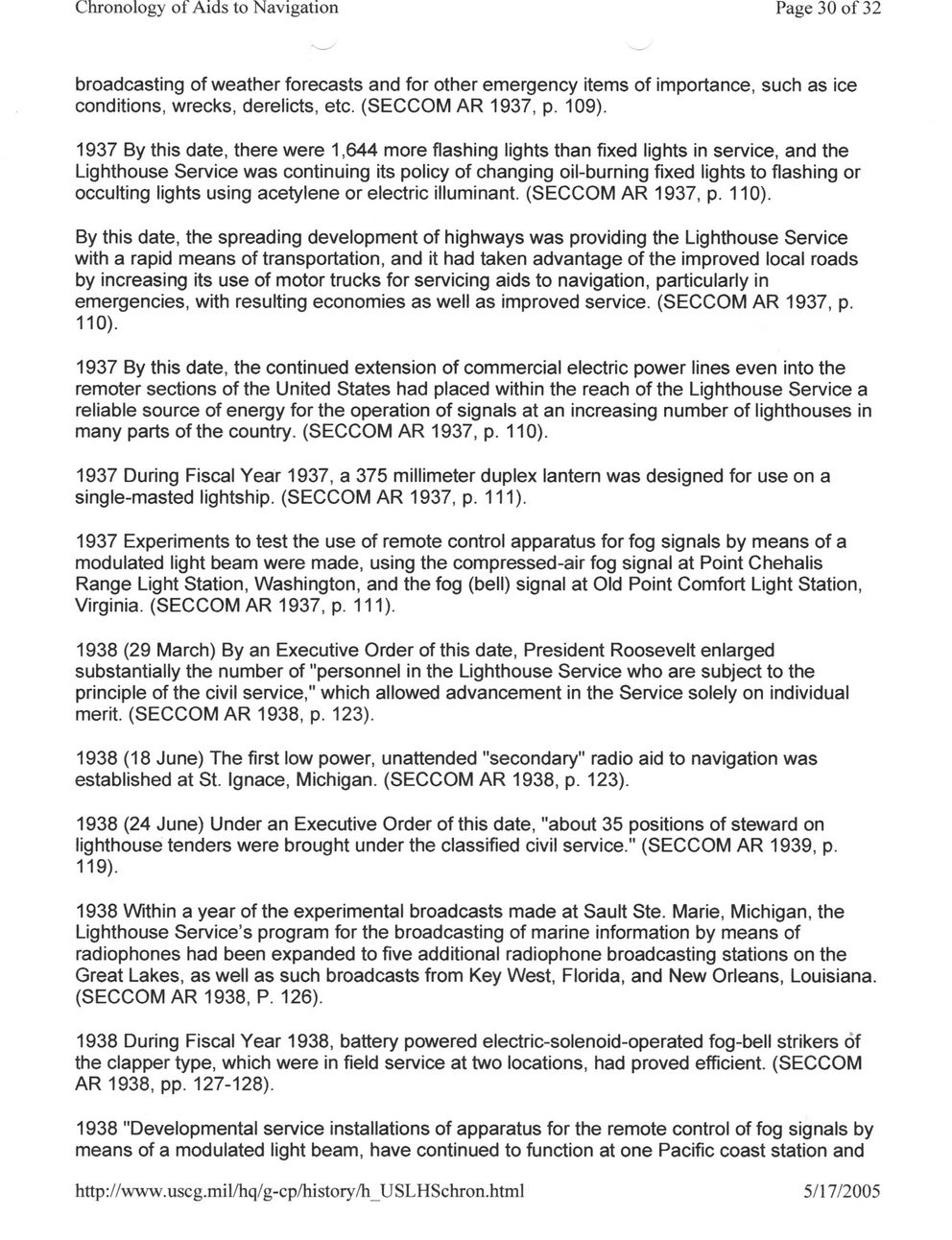This text was obtained via automated optical character recognition.
It has not been edited and may therefore contain several errors.
Chronology of Aids to Navigation Page 30 of 32 broadcasting of weather forecasts and for other emergency items of importance, such as ice conditions, wrecks, derelicts, etc. (SECCOM AR 1937, p. 109). 1937 By this date, there were 1,644 more flashing lights than fixed lights in service, and the Lighthouse Service was continuing its policy of changing oil-burning fixed lights to flashing or occulting lights using acetylene or electric illuminant. (SECCOM AR 1937, p. 110). By this date, the spreading development of highways was providing the Lighthouse Service with a rapid means of transportation, and it had taken advantage of the improved local roads by increasing its use of motor trucks for servicing aids to navigation, particularly in emergencies, with resulting economies as well as improved service. (SECCOM AR 1937, p. 110). 1937 By this date, the continued extension of commercial electric power lines even into the remoter sections of the United States had placed within the reach of the Lighthouse Service a reliable source of energy for the operation of signals at an increasing number of lighthouses in many parts of the country. (SECCOM AR 1937, p. 110). 1937 During Fiscal Year 1937, a 375 millimeter duplex lantern was designed for use on a single-masted lightship. (SECCOM AR 1937, p. 111). 1937 Experiments to test the use of remote control apparatus for fog signals by means of a modulated light beam were made, using the compressed-air fog signal at Point Chehalis Range Light Station, Washington, and the fog (bell) signal at Old Point Comfort Light Station, Virginia. (SECCOM AR 1937, p. 111). 1938 (29 March) By an Executive Order of this date, President Roosevelt enlarged substantially the number of "personnel in the Lighthouse Service who are subject to the principle of the civil service," which allowed advancement in the Service solely on individual merit. (SECCOM AR 1938, p. 123). 1938 (18 June) The first low power, unattended "secondary" radio aid to navigation was established at St. Ignace, Michigan. (SECCOM AR 1938, p. 123). 1938 (24 June) Under an Executive Order of this date, "about 35 positions of steward on lighthouse tenders were brought under the classified civil service." (SECCOM AR 1939, p. 119). 1938 Wthin a year of the experimental broadcasts made at Sault Ste. Marie, Michigan, the Lighthouse Service’s program for the broadcasting of marine information by means of radiophones had been expanded to five additional radiophone broadcasting stations on the Great Lakes, as well as such broadcasts from Key West, Florida, and New Orleans, Louisiana. (SECCOM AR 1938, P. 126). 1938 During Fiscal Year 1938, battery powered electric-solenoid-operated fog-bell strikers of the clapper type, which were in field service at two locations, had proved efficient. (SECCOM AR 1938, pp. 127-128). 1938 "Developmental service installations of apparatus for the remote control of fog signals by means of a modulated light beam, have continued to function at one Pacific coast station and http://www.uscg.mil/hq/g-cp/history/h_USLHSchron.html 5/17/2005

Lighthouses Chronology-of-Aids-to-Navigation-(29)